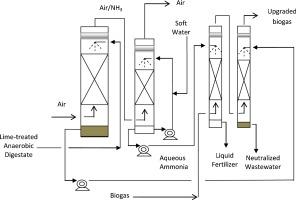Journal of Water Process Engineering ( IF 6.3 ) Pub Date : 2020-05-24 , DOI: 10.1016/j.jwpe.2020.101318 D. Georgiou , V. Liliopoulos , A. Aivasidis

|
Biogas is acknowledged worldwide as an increasingly important renewable energy source. After treatment, the upgraded biogas (biomethane) can be injected into the existing natural gas infrastructure, or it can be compressed for usage as a vehicle fuel. Upgrading of biogas by chemical absorption is considered among the most attractive scrubbing technologies. There are disadvantages though when using alkylamines, such as the energy-intensive regeneration step, degradation of the amines and the potential to form harmful chemical compounds. However, the latter disadvantages could be overcome by using non-conventional methods. In our lab-scale experiments, aqueous ammonia derived from air-stripping of a lime-treated anaerobic digestate proved very effective as biogas scrubber, decreasing carbon dioxide substantially (over 90%), and removing hydrogen sulfide (H2S) completely. Moreover, the alkaline aqueous effluent of the latter air-stripping process was very effectively neutralized by the biogas, while it also exhibited an important scrubbing potential (removing CO2 and H2S partially). Based upon the above experimental results, the flowsheets of an ammonia air-stripping/wet-scrubber and a biogas scrubbing unit, at a semi-industrial scale, were constructed and presented. Taking advantage of both the above acid gas chemical scrubbers could prove very beneficial for a cost-effective conversion of biogas to biomethane.
中文翻译:

利用氨水和厌氧消化的动物粪便中的空气汽提产生的碱性废水来提高沼气的利用率。在半工业厂房单元设计中的应用
沼气在世界范围内被视为一种越来越重要的可再生能源。经过处理后,可以将升级后的沼气(生物甲烷)注入现有的天然气基础设施中,也可以压缩后用作车辆燃料。通过化学吸收来提高沼气被认为是最有吸引力的洗涤技术之一。但是,当使用烷基胺时,存在一些缺点,例如能量密集的再生步骤,胺的降解以及可能形成有害化合物的缺点。但是,后一种缺点可以通过使用非常规方法来克服。在我们的实验室规模的实验中,通过对石灰处理的厌氧消化液进行空气汽提而获得的氨水被证明是非常有效的沼气洗涤塔,可大幅减少二氧化碳(超过90%),H 2 S)完全。此外,后面的气提过程中的碱性含水废水被沼气非常有效地中和,同时还显示出重要的洗涤潜力(部分去除了CO 2和H 2 S)。基于以上实验结果,构造并展示了半工业规模的氨气汽提/湿式洗涤器和沼气洗涤单元的流程图。充分利用上述两种酸性气体化学洗涤器可证明对将沼气经济地转化为沼气非常有益。











































 京公网安备 11010802027423号
京公网安备 11010802027423号